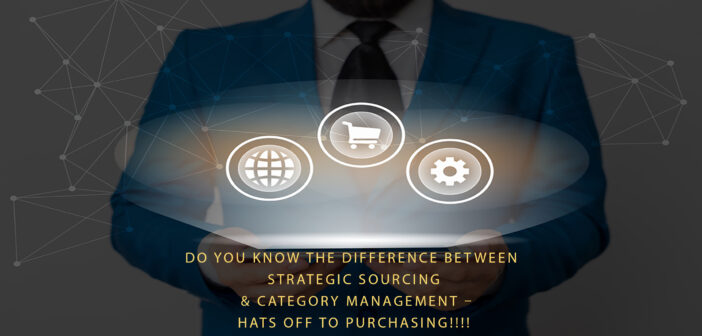A few weeks ago, I delivered a virtual training session to a Procurement (Purchasing) group that is part of an organization that is also responsible for Strategic Sourcing and Category Management. As you can imagine Purchasing professionals are often labeled with words such as tactical, transactional, non-strategic, etc. and looked upon as the least important of the group. But I would argue that nothing could be further from the truth. In fact, as the first line of defense for Procurement; if they don’t get it right nothing else matters. Consider the following:
Purchasing Vs. Strategic Sourcing
Purchasing IS A: Management control point where all significant purchases are monitored for the right authorization of the right item, at the right price, quality, and quantity, from the right supplier at the right terms, and at the right time. (BusinessDictionary.com)
Strategic Sourcing IS A: A rigorous, fact-based decision process that improves Total Cost of Ownership AND Increases Internal Stakeholder Value by leveraging the Total Spend of the organization, proactively managing supplier relationships, rationalizing demand, streamlining the purchasing process and focuses on Stakeholder Value Drivers. (The Mpower Group)
We would argue that Purchasing is the Actualization of the efforts of Strategic Sourcing AND Purchasing, Strategic Sourcing and Category Management MUST all work together to be successful. Consider this:
Here are the key roles that Purchasing professionals play. A few may be obvious but others are not:
Here are just a few of the ways that Purchasing plays a VERY strategic role within the Procurement function:
- Constantly finds opportunities to add value in the procure-to-pay process
- Uses technology to increase efficiency
- Supports supplier relationship management
- Proactively controls costs
- Manages contracts
- Supports Supplier Diversity & other corporate initiatives
- Drives ADOPTION of Procurement technology
- Establishes control mechanisms
- Identifies and mitigates risks
When I review this list, I see anything BUT non-strategic. The role of Purchasing will continue to become more and more of a value add for the Procurement function. Is your Purchasing organization here yet?
- Management understands the value of Purchasing in meeting Procurement’s goals
- Purchasing process is supported by functional management
- Purchasing is involved in critical Procurement Operations decisions
- Management staffs / supports Purchasing to maximize impact
- Purchasing staffed with high quality personnel
- Investment is made in infrastructure (process, tools, training, etc.)
- Purchasing is the first line of defense in risk management
- Senior management has Purchasing experience
- A stint in Purchasing is part of the rotation for “rising stars”
- Purchasing is the customer service arm of the Procurement function
- Purchasing is both a strategic and tactical differentiator for the Procurement organization
- Purchasing is key in ensuring “green” and “social responsibility” is top of mind
- Responsible to ensure Adoption of Procurement technology solutions
By the way, the Purchasing group plays a significant role in the Strategic Sourcing / Category Management process as well. Here are some of the ways they support the process:
- Provides supplier and category spend profile information (e.g. usage)
- Provides existing / historical pricing and contracts
- Identifies current Procurement Processes for categories being addressed
- Identifies leverage opportunities (spend, suppliers, processes)
- Provides Supplier Diversity information for suppliers
- Provides potential alternatives to consolidate / rationalize specifications
- Provides insights into demand patterns and variability of demand
- Provides data to support SKU rationalization
- Provides supplier cost drivers / TCO
- Provides lists of current, historical, and potential new suppliers
- Provides Qualitative/Quantitative Supplier Evaluation Criteria
- Supports development of RFP package as required
- Evaluates proposals as required
- Maintains dialogue with incumbent suppliers according to communication plan
- Ensures that communication / information sharing with suppliers is controlled
- Provides data to support the negotiation process
- Provides input into the negotiation strategy
- Transitions / implements “new” Supplier(s) (e.g. vendor set-up, item set-up, etc.)
- Ensures system changes complete to support optimized process
Shall I go on? For decades Purchasing has been relegated to the back office and the back burner. But the bottom line is that the Procurement function would be NOWHERE without their support. Hats off to Purchasing!!!
Let us know what you think and join in the conversation . . . . .


